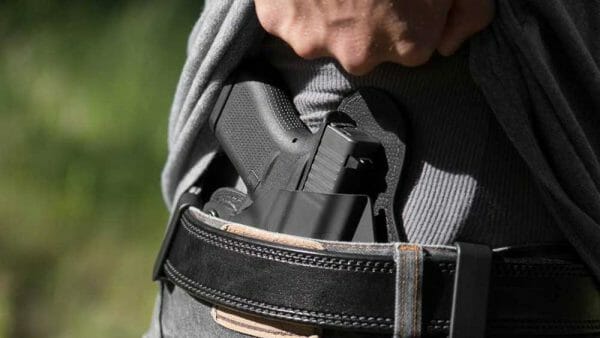
U.S.A. -(AmmoLand.com)- We start with a news report from ABC6 in Philadelphia, Pennsylvania.
It is 10:30 at night. You walk into a small restaurant to get your takeout order. You’re talking on the phone when a man behind the counter turns around, sees you, and points his gun at you. He orders you to hand over your phone. The three employees behind the counter have their hands up and are emptying the cash drawer. While you had your head in your phone, you walked in on a robbery in progress.
You’re a gun owner. You have your Pennsylvania concealed carry permit. You’re armed tonight. You hold your phone out as you draw your firearm. You shoot your attacker one time in the neck. Now the attacker drops his gun and falls to the ground.
You and the store employees call 911. You stay at the scene and talk to the police. Police recognized your attacker. EMTs say your attacker died at the scene. The police take your gun and ask you to talk to detectives as they review the security video.
Comments
Our defender did a number of things very well. The first thing is that he recognized a problem. It isn't unusual for victims to ask the robber to repeat his demands or to ask if the robber is joking. This is a natural response. We call it a normalcy bias where we experience something so unusual that we don't recognize what is happening. In an extreme case, the robbery is over before the victim is aware of what happened.
The best self-defense moves in the world don't work until we understand what is happening around us.
Our defender decided to defend himself and the other people in the store. He presented his firearm and hit his attacker in a vital area to quickly end the fight. Our defender then had the presence of mind to stop shooting. Most of us are taught to shoot until the threat stops, but there is a reactionary gap between the attacker's response to being shot and our new decision to stop shooting. It looks like our defender was prepared to shoot, and also prepared to stop shooting. Our defender stayed at the restaurant and gave a statement to the police. That is important because we want to establish ourselves as the victim of a violent encounter. There are a lot of details we don't know in this defense, and small details can make a critical difference.
Deciding to defend yourself with a lethal weapon doesn't mean you have to draw that instant. The attacker pointed his gun at the defender and that give the attacker a large advantage. The good news, of a sort, is that robberies are chaotic. We want to wait until the attacker has turned his attention, and hopefully his gun, somewhere else before we draw.
Having our hand on our gun cuts our draw time in half. If you can turn and mask your motions, then you probably gained a half-second by having your hand on the grip of your gun. That is particularly true in cold weather when many of us are wearing a heavy coat. Fortunately for us, reaching for a firearm also looks like getting your wallet out of your back pocket. That half-second is critical in a gunfight.
We also want to move as we draw. Instructors may argue about shooting on the move, but they agree that it is a good idea to move as we clear the gun from the holster and bring it onto the target. We move because movement buys us time. When the bad guy notices that something has changed, he will point his gun back to the location where we were the last time he noticed us. It is a huge advantage not to be there. It takes time for the attacker to notice we moved, to find us, and to point his gun at us. You experienced something like this when you alternate your shots between two targets at the shooting range. Your time between shots is longer than if you were simply shooting at one stationary target. Those fractions of a second add up.
Movement may have another purpose as well. We are responsible for every shot we fire. We might want to move so the ice machine is behind the attacker rather than letting a bullet fly through the kitchen. We can move to the side as well as up and down. We seldom have a perfect situation with a known backstop behind an attacker. Movement may give us an improvement from bad to better.
There is still a lot to do once the bad guy is down. Ask the employees and any other customers in the store if they are hurt. Ask them to look around and see if anyone else is injured.
Robbers often have friends waiting for them as they commit their crimes. Once the bad guy is down, then we want to lock the front and back doors. Maybe the store staff knows this, but maybe they'd appreciate the reminder.
If the immediate threat has ended, then our gun in our hand is no longer our friend. Take a breath or two. Then, carefully put your gun back in its holster. We would also like to cover the attacker's firearm if we can do so without significantly altering any evidence. Emotions are running high and we don't want one of the bystanders to grab the attacker's gun. People feel better once the attacker's gun is out of sight.
Everyone calls 911. You call. The store clerks and cooks call. Ask the shopkeeper from next door who came over after he heard the shot to call 911 too. Those phone calls identify the material witnesses who can affirm your defense. If the store employees don't have access to the security camera video, then ask them to call someone to get the video for you. You'd like your own copy separate from the copy of the video given to the police. At some point, you want to call your lawyer.
Be prepared for the police to take your weapon. They do the same to a policeman who discharges his firearm. I hope you get your gun back soon and in good shape. There are no guarantees.
If we were there, then we might want to do something a little different. We want to look before we enter a new environment so we can avoid potential problems. That means we might have to ignore a phone call that comes at the wrong moment.
The largest lesson is to think how we would act in this situation. Would we see the robbery unfold? Would we watch from outside and call the police? What would you do if your friends, family, or children entered the store before you looked inside? It is easier to come up with possible answers now than in the moment of a robbery. If you're fortunate enough to live with friends and family, then share that question with them.
Rob Morse highlights the latest self-defense and other shootings of the week. See what went wrong, what went right, and what we can learn from real-life self-defense with a gun. Even the most justified self-defense shooting can go wrong, especially after the shot. Get the education, the training, and the liability coverage you and your family deserve, join USCCA.
About Rob Morse
Rob writes about gun rights at Ammoland, at Clash Daily, and on his SlowFacts blog. He hosts the Self Defense Gun Stories Podcast and co-hosts the Polite Society Podcast. Rob was an NRA pistol instructor and combat handgun competitor.

The post Concealed Customer Meets Restaurant Robber – Armed Citizen Stories appeared first on AmmoLand.com.
from https://ift.tt/3qQ6qDJ
via IFTTT

No comments:
Post a Comment